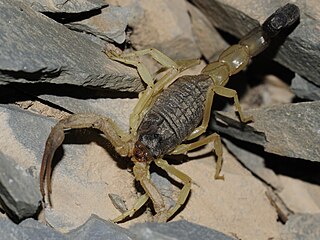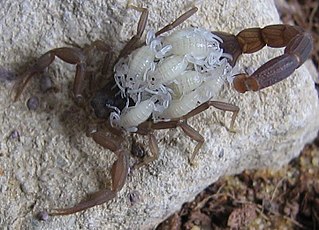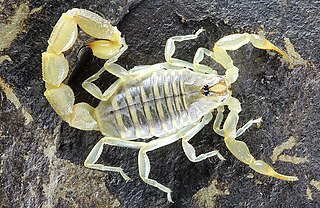
The Buthidae are the largest family of scorpions, containing about 100 genera and 1339 species as of 2022. A few very large genera are known, but a high number of species-poor or monotypic ones also exist. New taxa are being described at a rate of several new species per year. They have a cosmopolitan distribution throughout tropical and subtropical environments worldwide. Together with four other families, the Buthidae make up the superfamily Buthoidea. The family was established by Carl Ludwig Koch in 1837.
Buthacus is a genus of scorpion of the family Buthidae. It is distributed across northern and western Africa, Israel, Palestine, Jordan, Syria, the Arabian Peninsula, Iraq, Iran, Afghanistan, and Pakistan.

Hottentotta is a genus of scorpions of the family Buthidae. It is distributed widely across Africa, except for most of the Sahara desert. Species in the genus also occur in the Middle East, the Arabian Peninsula, southeastern Turkey, Iraq, Iran, Afghanistan, Pakistan, India, Nepal, Cape Verde Islands, and Sri Lanka (introduced).

Hottentotta tamulus, the Indian red scorpion, also known as the eastern Indian scorpion, is a species of scorpion of the family Buthidae. It occurs in most of India, eastern Pakistan and the eastern lowlands of Nepal, and recently from Sri Lanka.

Mesobuthus eupeus is a polymorphic scorpion species belonging to the well-known family Buthidae. Commonly known as the lesser Asian scorpion or the mottled scorpion. It is thought to be the most widely dispersed species of the genus Mesobuthus, perhaps even of the family Buthidae.

Compsobuthus is a genus of buthid scorpions.

Apistobuthus is a genus of scorpions in the family Buthidae. It was described by Susan Finnegan in 1932, and was for a long time considered to be monotypic, containing the single species A. pterygocercus. In 1998, a second species, A. susanae, was described by Wilson Lourenço; its specific epithet commemorates Susan Finnegan. A. susanae differs from A. pterygocercus in having stouter legs and pedipalps, among other characteristics. Both species are highly venomous and the second segment of their tail is wider than the others.
Hottentotta jabalpurensis is a species of scorpion, belonging to the family Buthidae. It was first found in Jabalpur, Madhya Pradesh, India.
Hottentotta jalalabadensis is a species of scorpion of the family Buthidae. It was first found in Afghanistan.
Hottentotta stockwelli is a species of scorpion of the family Buthidae. It was first found in Andhra Pradesh and Maharashtra, India.

Hottentotta conspersus, the Sesriem scorpion, is a species of scorpion of the family Buthidae.
Hottentotta caboverdensis is a species of scorpions of the family Buthidae. The species was described by Wilson R. Lourenço and Eric Ythier in 2006. The specific name caboverdensis refers to Cape Verde, where the new species was found.

Neobuthus is a genus of scorpion of the family Buthidae. It is distributed across the Horn of Africa; in Eritrea, Ethiopia, Somaliland, Kenya and Djibouti.

Charmus is a genus of buthid scorpions native to India and Sri Lanka.

Reddyanus is a genus of buthid scorpions native to Oriental region from India, Sri Lanka, China: Tibet, to Melanesia. The genus was previously described as a subgenus of Isometrus.

Hottentotta jayakari, the black-tailed alligatorback scorpion, is a species of scorpion of the family Buthidae. It is geographically widespread, occupying much of the Arabian Peninsula and Iran.

Hottentotta hottentotta, also known by its common name alligatorback scorpion is a species from the genus Hottentotta. The species was first described by Johan Christian Fabricius in 1787. The species is found in West Africa. Females are capable of parthenogenesis.

Hottentotta rugiscutis is a species of scorpion which is endemic to India.
Susan Finnegan was a British zoologist, who specialised in the study of mites and ticks. She was the first woman appointed to a scientific post at the Natural History Museum, London, in 1927, and was the first woman to describe and name a new genus of scorpion, Apistobuthus. Two species of scorpion have been named in her honour. Finnegan was required to resign her post at the Natural History Museum in 1936, in order to marry her fellow museum worker Walter Campbell Smith.















